
For instance, NVIDIA (NVDA) reported total net income or accounting profit of $9,75 billion for the 2022 fiscal year compared to the $4.33 billion it earned in 2021. Unlike economic profits, accounting profits does not include opportunity costs. Accounting profit is different than economic profit, which includes such things as opportunity cost. Unlike explicit costs that can be easily calculated, how to calculate accounting profit an opportunity cost is a potential source of profit that was lost by pursuing another course of action. The best way to see what goes into accounting profit is to look at an income statement, which is also commonly called a profit and loss statement. This statement is one of the main financial statements of a company and shows the company’s revenue and expenses during a particular period.

Thus, it includes the entire cost of goods sold, as well as all selling, general and administrative expenses, financing costs, and realized gains and losses. Because of its comprehensiveness, accounting profit is a more reliable indicator of overall results than the gross profit or operating profit figures. Accounting profit is revenues minus all expenses, while gross profit is revenues minus just the cost of goods sold. The gross profit figure can be found higher in the income statement, as a calculated number inserted after the cost of goods sold. If the reporting entity is a retailer, then the gross profit figure can be found after the cost of merchandise sold.
Gross profit margin vs net profit margin: What’s the difference?
The accounting profit is generally greater than the economic profit, but in cases where the opportunity cost is zero, it is equal to the economic profit. So, through this example, we can see and observe that the explicit costs (rent and wages) are deducted from the company’s revenue to calculate the company’s accounting income. Accounting profit helps us see the actual profits a company makes, not just the theoretical numbers that economic profit looks at. This profit is calculated for loan, interest, and growth, whereas economic profit determines a company’s total production cost and total value. What’s important to know is that accounting profit is different from economic profit and underlying profit. Economic profit, on the other hand, takes into account more factors, and underlying profit tries to eliminate the impact of nonrecurring items.
- Economic cost and accounting cost differ because economic costs include opportunity costs, or the cost of what is given up to pursue another economic avenue.
- The company’s bottom line is important for investors, creditors, and business decision-makers alike.
- Normal profit is an economic term that refers to a situation where the total revenues of a company are equal to the total costs in a perfectly competitive market.
- Accounting profit is one of the primary sources of information used by investors, because it includes all required reporting of both revenues and expenses.
- Your profit margin shows how much money you make from every dollar of your gross revenue.
- This means that Company A currently has a gross profit margin of 42%.
One is gross margin, which is derived by subtracting the cost of goods sold from net revenues. It is most useful for understanding how much is being earned from the sale of goods and services, before administrative and financial costs are subtracted. The second type of profit is operating profit, which is derived by subtracting all operating expenses from the gross margin. This is a good measure of the profitability of a firm’s core operations, prior to taxes and financing costs.
Understanding Accounting Profit
If you are a business owner, improving your profit margin is an important part of growing your company. Your profit margin shows how much money you make from every dollar of your gross revenue. When you improve your profit margin, you actually make more money without needing to increase sales or gross revenue. Operating profit is a slightly more complex metric, which also accounts for all overhead, operating, administrative, and sales expenses necessary to run the business on a day-to-day basis. While this figure still excludes debts, taxes, and other nonoperational expenses, it does include the amortization and depreciation of assets. Understanding the concept of accounting profit is essential for businesses to gauge their financial performance accurately.
- Having said that, you can use a scale of how a business is doing based on its profit margin.
- Total revenue refers to the total receipts from sales of a given quantity of goods or services.
- The healthy gross and operating profit margins in the above example enabled Starbucks to maintain decent profits while still meeting all of its other financial obligations.
- Non-publicly traded companies are not required to conform to GAAP’s standards, but the result may be a less favorable view from lenders and creditors.
- As such, the business owner would have an economic loss of $30,000 ($120,000 – $100,000 – $50,000).
- Unlike accounting profit, underlying profit can be subjective and is based on one’s own opinion about what the true earnings should be for a company.